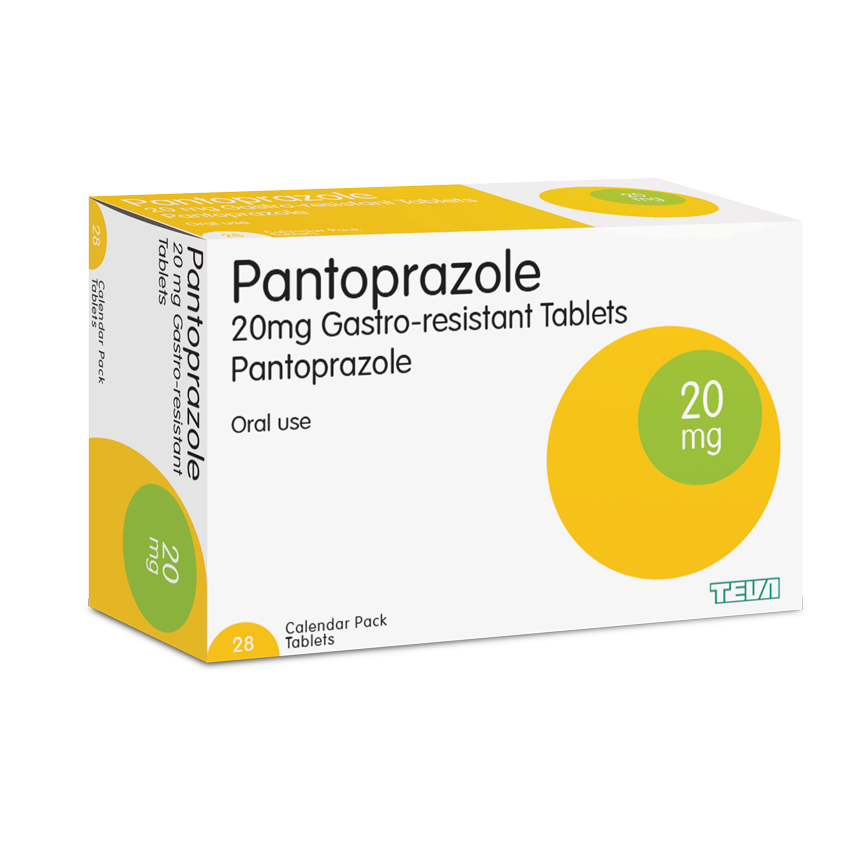*Brands may vary. please contact us for specific brands.
Pantoprazole Tablets (28 Tablets)
£24.99 – £26.99
- Treatment For Acid Reflux Prevention
- Active Ingredient: Pantoprazole
- Reduces Amount Of Stomach Acid Produced
- Buy With Confidence From UK Registered Pharmacy
- Includes Free Prescription
Gastro-oesophageal reflux disease (GORD) can be treated with Pantoprazole, which works by reducing the amount of acid your stomach produces, preventing acid reflux, as well as helping to prevent and treat stomach ulcers.
| Options | Price | Stock |
|---|---|---|
| 20mg | £24.99 | In Stock |
| 40mg | £26.99 | Out of Stock |

Discreet Packaging

UK Based
-
- Overview of Pantoprazole Tablets
- What is Pantoprazole?
- Key Features and Benefits
- Pantoprazole Side Effects
- Pantoprazole vs Omeprazole
- How to Use Pantoprazole Tablets
- Purchase Information
Overview of Pantoprazole Tablets
Welcome to My Pharmacy, your dedicated and reliable source of pharmaceutical products in the UK. Today, let’s delve deep into the world of Pantoprazole, a potent medication often recommended for conditions related to excess stomach acid. My Pharmacy offers a swift and confidential service to Buy Pantoprazole Tablets Online with next day delivery options available for your convenience. Pantoprazole 40 mg and Pantoprazole 20 mg tablets belong to the proton pump inhibitor (PPI) class of medications, primarily designed to reduce stomach acid, thereby providing relief from acid-related conditions. These tablets are effective for both adults and children above 12 years of age suffering from diseases like acid reflux.What is Pantoprazole?
Pantoprazole is a proton pump inhibitor (PPI). It is designed to offer relief to individuals suffering from conditions caused by excessive acid production in the stomach. Pantoprazole functions by effectively inhibiting the action of proton pumps located in the stomach lining. These proton pumps are responsible for secreting stomach acids. By reducing acid production, Pantoprazole aids in alleviating symptoms related to acid reflux and prevents damage to the lower esophagus caused by stomach acid. While Pantoprazole shares similarities with other PPIs like Omeprazole and Esomeprazole, each drug has unique properties, indications, and potential interactions. These distinctions might influence a healthcare provider's decision to prescribe one PPI over another based on a patient's specific health profile and treatment needs.Key Features and Benefits
Understanding Pantoprazole: Pantoprazole tablets effectively treat various stomach and intestinal acid-related diseases, providing relief from symptoms such as persistent coughs, a hoarse voice, bad breath, bloating, and the feeling of nausea. For a comprehensive understanding of acid reflux, refer to this article from the NHS Website. Dosage Forms & Strengths: Pantoprazole is available in 20mg and 40mg tablets, meeting the varied dosage requirements of different patients.Pantoprazole Side Effects
Understanding the potential side effects of Pantoprazole, along with necessary precautions, ensures safe and effective use of this medication. Common Side Effects Pantoprazole is generally well-tolerated by most individuals, but like all medications, it can cause side effects. The most common side effects of Pantoprazole include but are not limited to:- Headache: Users may experience headaches after taking the medication.
- Diarrhoea: Loose stools or an upset stomach may occur.
- Nausea: Some individuals might feel nauseous.
- Bloating: Pantoprazole might cause bloating or a feeling of fullness in the stomach.
- Skin Rash: Though rare, some users may develop a rash.
- Abdominal Pain: Users may experience stomach pain.
Pantoprazole vs Omeprazole
Both Pantoprazole and Omeprazole fall under the category of proton pump inhibitors (PPIs), providing relief from acid-related disorders by reducing stomach acid production. Understanding the differences and similarities between these two medications can aid patients and healthcare professionals in making informed decisions. Similarities Pantoprazole and Omeprazole work similarly by blocking the proton pump in the stomach lining, reducing acid production effectively. Both medications are used to treat various acid-related conditions, such as gastroesophageal reflux disease (GERD), stomach ulcers and damage to the lower oesophagus caused by acid reflux. Studies have shown that both drugs are equally effective in managing acid-related disorders when taken at recommended doses. Differences While both drugs act quickly, the onset of action may vary. Omeprazole often starts reducing stomach acid within an hour, while Pantoprazole might take slightly longer. Pantoprazole tends to have a longer duration of effect compared to Omeprazole, providing extended relief from acid reflux symptoms. While both drugs have interactions, the specific drugs they interact with may differ. Patients should provide their healthcare provider with a complete list of medications they are taking, including prescription, over-the-counter and herbal supplements. Although they share many common side effects, some adverse effects may be unique or more prevalent in one medication over the other. For instance, Omeprazole might have a higher tendency to interact with other drugs metabolised by the liver. Ultimately, the decision between Pantoprazole and Omeprazole should be made based on individual health profiles, the specific condition being treated, and patient response to the medication. It’s essential to consult with a healthcare provider to discuss treatment options, side effects and potential drug interactions before starting either medication.How to Use Pantoprazole Tablets
Take Pantoprazole tablets one hour before meals without breaking or chewing them. The usual dose varies, so it’s crucial to follow your doctor’s prescription, considering factors like the treatment period and potential dosage increase. For further details on Pantoprazole uses and administration, watch this YouTube Video. https://www.youtube.com/watch?v=UMk_cZcSrZMPurchase Information
Before making a purchase, check the ingredient list to ensure you have no sensitivities or allergies to the components. For secure and confidential purchase of Pantoprazole tablets online with the convenience of next-day delivery, trust My Pharmacy, the UK’s trusted online pharmacy. Explore a wide range of acid reflux treatments, including Lansoprazole, Esomeprazole, Omeprazole and Nexium, all available at My Pharmacy. For any further assistance, feel free to reach out to our dedicated customer service team at info@mypharmacy.co.uk. Discover our full range of heartburn treatments and make an informed decision for a symptom-free life! -
Acid Reflux
Heartburn is a burning feeling in the chest caused by stomach acid travelling up towards the throat (acid reflux). If it keeps happening, it’s called gastro-oesophageal reflux disease (GORD).
Check if you have acid reflux
The main symptoms of acid reflux are:heartburn – a burning sensation in the middle of your chest
an unpleasant sour taste in your mouth, caused by stomach acid
You may also have:a cough or hiccups that keep coming back
a hoarse voice
bad breath
bloating and feeling sick
Your symptoms will probably be worse after eating, when lying down and when bending over.Causes of heartburn and acid reflux
Lots of people get heartburn from time to time. There’s often no obvious reason why.Sometimes it’s caused or made worse by:
certain food and drink – such as coffee, alcohol, chocolate, and fatty or spicy foods
being overweight
smoking
pregnancy
stress and anxiety
some medicines, such as anti-inflammatory painkillers (like ibuprofen)
a hiatus hernia – when part of your stomach moves up into your chestHow you can ease heartburn and acid reflux yourself
Simple lifestyle changes can help stop or reduce heartburn.Do:
Eat smaller, more frequent meals
Raise one end of your bed 10-20cm by putting something under your bed or mattress – to make it so your chest and head are above the level of your waist, so stomach acid doesn’t travel upwards towards your throat
Try to lose weight if you’re overweight
Try find ways to relaxDon’t:
Have food or drink that triggers your symptoms
Eat within 3 or 4 hours before bed
Wear clothes that are tight around your waist
Smoke
Drink too much alcohol
Stop taking any prescribed medicine without speaking to a doctor firstA pharmacist can help with heartburn and acid reflux
Speak to a pharmacist for advice if you keep getting heartburn.They can recommend medicines called antacids that can help ease your symptoms.
It’s best to take these with food or soon after eating, as this is when you’re most likely to get heartburn. They may also work for longer if taken with food.
See a GP if:
Lifestyle changes and pharmacy medicines aren’t helping
You have heartburn most days for 3 weeks or more
You have other symptoms, like food getting stuck in your throat, frequently being sick or losing weight for no reasonYour GP can provide stronger treatments and help rule out any more serious possible causes of your symptoms.
-
Side Effects
Most people who take Pantoprazole do not have any side effects. If you do get a side effect, it is usually mild and will go away when you stop taking Pantoprazole.
Talk to your pharmacist or doctor if these side effects bother you or don’t go away:
Headaches
Diarrhoea
Feeling sick or being sick (nausea or vomiting)
Constipation
Stomach pain or wind
<strong>
Serious side effects</strong>Serious side effects are rare and happen in less than 1 in 1,000 people.
Call a doctor straight away if you have:
Joint pain and a red skin rash, especially in parts of your body exposed to the sun, such as your arms, cheeks and nose. These can be signs of a rare condition called Subacute Cutaneous Lupus Erythematosus that can happen weeks or even years after taking Pantoprazole.
Reddening, blisters and peeling of the skin. There may also be severe blisters and bleeding in the lips, eyes, mouth, nose and genitals. These could be signs of a rare reaction to the medicine called Stevens-Johnson syndrome or Toxic Epidermal Necrolysis.
Stomach pain that gets worse, yellow skin (or the whites of your eyes turn yellow), dark pee. These can be signs of liver problems.
pain when you pee, peeing less, lower back pain, swollen ankles, and rash or fever. These could be signs of a kidney problem.Serious allergic reaction
In rare cases, it’s possible to have a serious allergic reaction to pantoprazole.
-
Patient Information
For further information see the manufacturers patient information leaflet.













